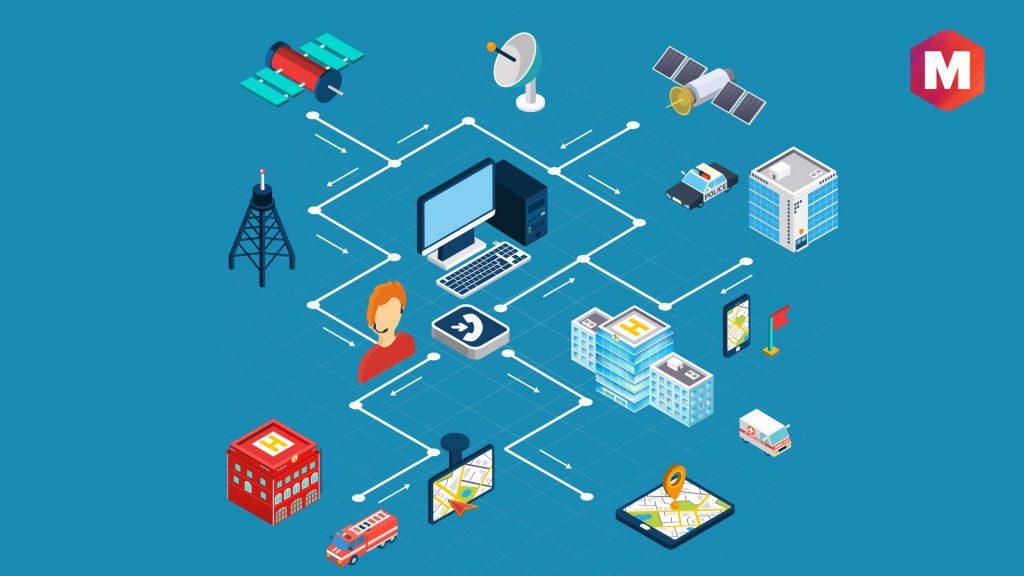Communication systems is the process of handling written or verbal messages. It’s a process called communication which is more often than not taken for granted. Communications networks or communication channel can be as simple as writing a letter or talking to somebody. However, it can also involve advanced computer systems and even satellites.
Table of Contents
What are Communication Systems?
Communication systems are defined as the interchange of information or ideas between two entities. The process of communication systems involves the exchange of both formal as well as informal information, and it consists of receiving, sending, and processing information. The digital communication systems used may take place between employees and supervisors within the business or outside the business. It can be written, visual, verbal, or non-verbal.
The objective of the communication process is the exchange of ideas, convey of information, and understanding other entities. Therefore information is passed from one place to the other that is from the receiver to the sender.
There are several elements involved in the process of communication systems. The ultimate objective, however, remains to pass information from the sender to the receiver.
Looking to enhance your communication systems?
Tip 1: Upgrade to modern technologies like 5G networks and fiber optics. Implementing fiber optic communication systems can boost your data transmission speeds up to 100 Gbps or more, significantly outperforming traditional copper cables. This upgrade enhances efficiency and reliability in your communication infrastructure (Source: IEEE Communications Society).
Tip 2: Prioritize security within your communication channels. With cybercrime damages projected to cost the world $10.5 trillion annually by 2025, it’s crucial to implement strong encryption and secure protocols to protect sensitive information (Source: Cybersecurity Ventures).
Communication systems are crucial in every aspect of information and idea transfer. Since several elements are involved in communication systems, care has to be taken that the chain of those elements is not broken while transferring the message.
For example, a transmitter is an element in a communication system that transfers the information or the message from the sender to the receiver.
If the transmitter malfunctions, then the entire process of the communication system fails. Likewise, every other element of the communication system is essential.
Types of Communication System
1. Optical Communication System
When light is used to send a message from one medium to another, then the optical communication system is used. The message is transformed into signals, and the signals are transferred from the sender to the receiver.
The receiver receives the signal, decodes it, and understands and responds accordingly. The entire system of optical and communication technologies is dependent on light. For example, helicopters and airplane landings work on the same principle of the optical communication system.
Light signals are received from the base and then decide the next steps. Optical and wireless communications and systems are also used by railways and even on roads in the form of traffic signals. Greenlight is for go, while Red light is a signal to stop.
SOS signals also use optical communication systems.
2. Radio communication system
As the name suggests, the radio communication system makes use of radio to transmit a communication from the sender to the receiver. This communication system requires the use of an antenna receiver at both ends of line communication.
The electrical signals travel and are produced with the help of an antenna, which is transmitted to the signal at the receiver end. The communication message is transferred with the help of waves.
Radio has a signal filter to filter out different signals. Information on some signals is unwanted while some signals are wanted. Therefore, radios have a tuning facility by which the receiver can tune to a particular frequency on which you can receive the intended message of the sender.
The signals are decoded by the radio and are easily understandable for the listeners.
3. Duplex Communication systems
As the name suggests, duplex communication systems involve the use of two different types of equipment to communicate with each other. These two types of equipment are used at the same time.
For example, in the video call, both the callers can see each other and talk simultaneously. The other person can hear and speak at the same time. Therefore this system of describing communication can be considered as advanced as compared to radio and light communication systems.
The process of the communication channels in the duplex communication systems takes place at the same time, while radio and light communication systems do not make this possible.
4. Half-duplex communication systems
In this communication system, unlike the duplex communication system, both parties cannot communicate at the same time. One person has to stop sending the signal to the other person and wait till the other person responds.
For example, a walkie-talkie follows a half-duplex communication system. At the end of every sentence in Walkie Talkie, the sender is expected to say ‘over’ so that the receiver can start sending feedback based on the message sent by the sender.
5. Tactical communication system
In a tactical communication system, the communication varies as the environmental condition varies in them.
Elements of Communication systems
Following the common elements of communication systems
1. Information
Information is the message which is to be transferred from the sender to the receiver or from the input signal or receiver to the sender as feedback. The format of information can be anything from text, to video or combination of any form of available message formats.
2. Signal
The signal is the carrier of the information. The message is converted into a signal for transmission from one end of electronic circuit to the other.
3. Transducer
The transducer can also be termed as a converter since it converts energy from one form to the other. The converter can convert temperature, pressure, force into respective electrical signals. For example, a phone call can transfer our voice to the sender by converting the voice into audio signals.
4. Amplifier
The device which helps to increase the strength of the transmitted signal is called an Amplifier. Amplification is done to increase the frequency of the message, which is being sent.
5. Modulator
Sometimes the message is to be transmitted across large distances. These messages tend to have low frequency and amplitude. To increase their reach, these messages are coupled with carrier waves, which are high amplitude and high-frequency waves.
This process of capturing high-frequency waves with the message is called modulation. The resultant modulation wave is the message which is to be transmitted.
There are three different types of modulations present based on the changes carried out:
-
Amplitude modulation – When the amplitude is changed and superimposed on the carrier wave of high frequency, it is called amplitude modulation.
-
Frequency modulation – In this technique, the frequency is altered by motivating the signal with a carrier wave. Frequency modulation is better and more efficient than amplitude motivation since noises are eliminated from different sources.
-
Phase modulation – The phase of the carrier wave changes the phase of the signal wave.
6. Transmitter
The message is converted into a signal with the help of equipment, which is called a transmitter. The transmitter is present on the sender’s site, and at the site of the recipient, it may be present as a receiver.
7. Antenna
The structure or device that receives electromagnetic waves from air, transmitted from the sender, is called an Antenna. It is also defined as the structure which can convert the message into waves to transmit it further is called an antenna.
The antenna is metallic and requires multiple wires to function.
8. Channel
When the antenna converts the message, it is transferred by wire or cable or space, called a channel.
9. Noise
The hurdle between the sender and the receiver is termed as noise. Noise primarily disrupts or Interrupts the message which is being transferred from the sender to the receiver. This interference can be in the form of physical interruption, lightning, solar radiation, or any other relevant type of distraction.
The channels are designed in such a way to eliminate the external destruction or minimized. Noise may happen due to the random collision of electrons in the conductors. Attempts are made to reduce or eliminate noise internally by the use of digital technology.
10. Attenuation
Attenuation is the problem caused by the medium when the signal is traveling long distances by a medium. This depends on the length of the medium. The range of the medium is directly proportional to the loss in initial power.
Digital signals are less prone to attenuation as compared to analog signals.
11. Distortion
It is one of the problems of the channel. The transmitted message is at a specific bandwidth and frequency. However, when distortion of this, the frequency and bandwidth.
12. Receiver
The receiver is at the far end of the communication system, and functions as a receiver for the message sent by the sender. It is a device that is devised for giving an output to the receiving signal.
The receiver also translates the message to the person on the receiving end. In two way communication, the receiver also acts as a sending device and transmits the message back to the sender.
13. Demodulator
The function of demodulation is the exact opposite of modulation. In modulation, the message is coupled with the carrier, while in demodulation, the message is separated from the carrier wave.
14. Repeaters
Repeaters are present in multiple locations between the receiver and transmitter. The repeater’s primary function is to amplify the signal which it receives and send it to the next repeater while ensuring that the message does not get distorted.
Conclusion
The communication systems are an essential part of the communication process. These systems enable the transfer of information and the exchange of ideas from remote places.
While the system is complex with the involvement of multiple elements, the process of communication remains the same in almost all the aspects or types of communication systems.
Liked this post? Check out the complete series on Communication



